In this guide, we will quickly compare the Raspberry Pi 5 to the Raspberry Pi 4.
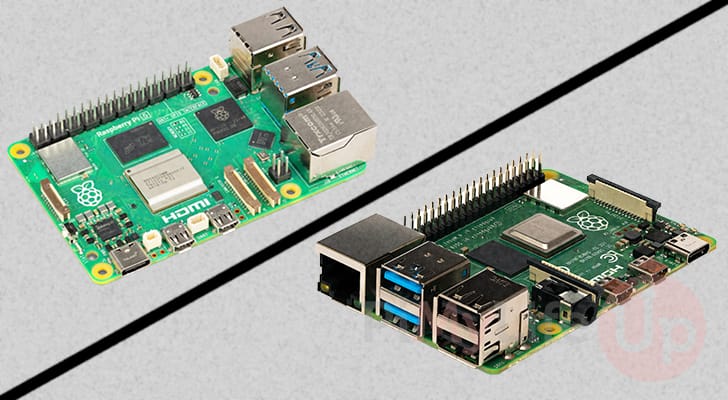
The release of the Raspberry Pi 5 brought several improvements over its predecessor while also introducing a few drawbacks.
With the Raspberry Pi 4 set to continue to be manufactured for the next few years, you will want to know some of the key differences between these two models.
If you don’t want to read too deep into this article, then summarizing it the Raspberry Pi 5 offers significant performance improvements over the Pi 4.
Additionally, it also significantly improves the I/O capabilities of the device, allowing you to make the most of the USB 3.0 ports that were introduced with the older Raspberry Pi 4.
These improvements at the cost of both power and thermal performance as well as a removal of the stereo audio jack.
You might also notice that the Raspberry Pi 5 has flipped around the position of the ethernet and USB ports. The USB Ports are now near the GPIO pins and the ethernet port is closer to the HDMI ports.
Comparing the Specification of the Raspberry Pi 5 and 4
Below you can see a table that explores the major differences between the Raspberry Pi 5 and the Raspberry Pi 4.
Overall, the Pi 5 adds a ton of features to the lineup without sacrificing its tiny form factor. The board has the same dimensions as previous generations.
| Raspberry Pi 5 | Raspberry Pi 4 | |
|---|---|---|
| SoC | Broadcom BCM2712 | Broadcom BCM2711 |
| — CPU | Quad-Core Cortex-A76 (ARM v8) 64-bit @ 2.4 GHz | Quad core Cortex-A72 (ARM v8) 64-bit @ 1.8 GHz |
| — GPU | VideoCore VII @ 800 MHz Supports: OpenGL ES 3.1, Vulkan 1.2 | VideoCore VI @ 500 MHz Supports: OpenGL ES 3.1, Vulkan 1.0 |
| Display Output | 2 x 4kp60 MINI HDMI Display Output Both can use 4kp60 | 2 x 4kp60 Mini HDMI One at 4Kp30 when both in use |
| Memory | LPDDR4X-4267 SDRAM 4GB, or 8GB | LPDDR4-3200 SDRAM 1GB, 2GB, 4GB or 8GB |
| Storage | Micro SD (SDR104 Compatible) M.2 NVME SSD Support via HAT | Micro SD |
| GPIO | 40 PIN – Compatible with old Raspberry Pi HAT’s | 40 PIN |
| USB | 2 x USB 2.0 2x USB 3.0 @ 5 Gbps | 2 x USB 2.0 2 x USB 3.0 |
| Connectors | 2 x 4-lane MIPI camera / display transceivers PCIe 2.0 x1 Interface UART Breakout RTC Clock Power 4-Pin FAN Power | 2-lane MIPI DSI Display Port 2-lane MIPI CSI Camera Port 4-Pole Stereo Audio and Composite Video Port |
| Networking | Dua-Band 802.11ac Bluetooth 5 / BLE Gigabit Ethernet PoE via POE + Hat (Incompatible with old version) | Dua-Band 802.11ac Bluetooth 5 / BLE Gigabit Ethernet PoE via POE + Hat |
| Power Button | Soft power button | None |
| Power Input | 5V 4A via USB-C Port PoE via POE+ HAT (Incompatible with old version) 5V via GPIO | 5V 3A via USB-C Port POE via POE+ HAT 5V via GPIO |
Quick overview of the Differences Between the Pi 5 and the Pi 4
This section will quickly compare the significant changes from the Raspberry Pi 5 to the Raspberry Pi 4. We will break this down into a couple of subsections.
Performance
If you are running a project that requires as much performance as possible, you can’t pass the Raspberry Pi 5.
While the model numbers for its CPU and GPU might not sound like huge increases, they bring a lot to the table. Both the CPU and GPU of the Raspberry Pi 5 are significantly more efficient than the ones used on the Pi 4.
On top of this improved efficiency, the Raspberry Pi 5 is clocking its CPU cores 600 MHz faster than the Pi 4. Combined, these lead to a pretty significant CPU advantage.
In terms of GPU power, the improvements are just as great. The VideoCore VII architecture boasts numerous compatibility and efficiency improvements while being clocked 300 MHz faster than the VideoCore VI Used in the Raspberry Pi 4.
The Raspberry Pi 5 also offers support for Vulkan 1.2 compared to the Pi 4 that only supports 1.0.
Additionally, the memory has also been updated to be even faster on the Raspberry Pi 5. The LPDDR4X architecture used on the Pi 5 allows almost double the speed of the LPDDR4 memory used on the Raspberry Pi 4.
To learn more, check out our article on benchmarking the Raspberry Pi 5. We directly compare the Pi 5’s performance to the Pi 4 within that article.
Display Output
Display wise, the Raspberry Pi 5 is almost the same as the Raspberry Pi 4. They both offer dual display output at 4k resolution. However, the Pi 5 has improved in one crucial place: the max refresh rate.
When using a Raspberry Pi 4 with dual monitors, you will be locked to only one display at 4k 60Hz, with the other having to run at the slower 4k 30Hz.
With the Raspberry Pi 5, this has been improved, with it now being able to handle both HDMI displays running at 4k 60Hz.
Connection wise, the Raspberry Pi 5 and 4 use the same Micro-HDMI ports.
IO Capability
If you plan to run a Raspberry Pi as a NAS, then you should choose the Raspberry Pi 5 over the Pi 4.
The Raspberry Pi 5 introduced a new chip that helps the system maintain much faster rates on both its USB ports while adding a PCIE lane.
This PCIE lane offers the ability for the device to be extended with support for other storage mediums, including the NVME M.2 standard even if it would be limited to PCIE 2.0 speeds.
The Raspberry Pi 4 has to share its USB bus with other core components. This is no longer the case with the Pi 5. You should now get significantly improved speeds from its USB 3.0 ports. However, this may become increasingly taxing on the CPU.
Networking
Networking wise the Raspberry Pi 5 and Raspberry Pi 4 are identical. There are no significant improvements to networking with the Pi 5. You see no benefit from using the Pi 5 over the Pi 4 in this category.
If you have issues with the Wi-Fi, Bluetooth, or Ethernet with older Pi’s, then you likely won’t see an improvement here.
Power Usage
The Raspberry Pi 5 can be even more power-hungry than the Pi 4. In fact, it can draw enough power that the USB-C power supplies designed for the Pi 4 are no longer fully supported.
Even though the Pi 5 will draw less power for the same workload as the Raspberry Pi 4, it can scale much higher, significantly increasing the power draw.
If you upgrade to a Raspberry Pi 5 from a Pi 4, you can still use the same power supply, but the Pi will automatically limit itself. You won’t get the most out of your device, so buying a new official power supply will be worth it.
If you are running a project that doesn’t have much leeway with the power that can be delivered, then you should consider sticking with a Raspberry Pi 4. It is still a decent board. You just miss out on the performance improvements.
Temperature
Temperature wise, you will see much better thermals from the Raspberry Pi 4. The new processor and increased power usage of the Raspberry Pi 5 have come at a detriment to its thermals.
Without an active cooler, the Pi 5, under continual load, cannot keep itself cool and will begin to thermal throttle. While you could get away with a small passive cooler on the Raspberry Pi 4, this is no longer true.
The one saving grace is that the Raspberry Pi 5 has made using a FAN a simpler process with the introduction of a 4 pin FAN header on the board itself.
Connectors
The Raspberry Pi 5 sees some significant changes with its connectors, especially regarding the camera ports.
On the Raspberry Pi 4, you would find a separate DSI port for displays and a CSI port for cameras. These have both been replaced.
Instead, on the Pi 5, you will find two 4-lane MIPI ports that are used for both cameras and displays. These new ports require different cables than the older ones used. This means you will need to invest in converter cables if you are heavily reliant on the Raspberry Pi cameras.
Additionally, the Pi 5 has several additional connectors that increase the board’s functionality over the Pi 4.
The first is an RTC power port that allows you to supply battery power to the new RTC chip built into the Raspberry Pi 5. This is a significant advantage if you need time to be maintained and don’t want to rely on a third-party solution.
The second major connector is the inclusion of a new UART breakout. This breakout was not readily available on the Raspberry Pi 4.
The third addition is the fan header, which lets you quickly hook up a FAN with PWM control and tacho feedback.
However, these additions came with removing the 4-Pole stereo jack available on the Raspberry Pi 4. If you rely on a stereo jack and can’t use USB or HDMI for audio, then you will want to hold off on moving to the Raspberry Pi 5.
Conclusion
Comparing the Raspberry Pi 5 and Raspberry Pi 4, you will see they have many similarities and significant differences.
With the Raspberry Pi 5, you get significantly improved performance and better IO capabilities, but at the cost of the analog audio output and increased power usage and thermals.
Hopefully, this guide has helped you compare the two devices. If you feel like we have missed something, please feel free to comment below.
Once you have chosen which Raspberry Pi you will go with, explore our numerous Raspberry Pi projects.
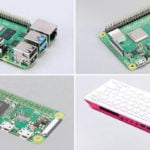
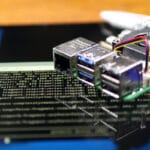


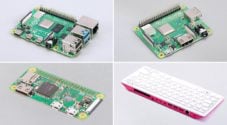
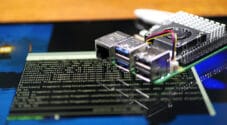
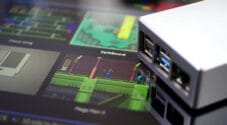



Will the form factor change? Can you use the same cases for the new ones?
Hi Mike,
While the Raspberry Pi 5 is the exact same size, the position of the components such as the USB and ethernet ports has changed and the removal of the audio / composite video jack will break the support with most cases.
Kind regards,
Emmet
The 5 looks great with one huge disappointment. We use that stereo jack and therefore won’t be upgrading to any 5’s anytime soon.
Thanks for the comparison – I learned stuff about the PI 4!
I think there is a typo in the following sentence – I suspect the second Pi 5 should be Pi 4.
“Even though the Pi 5 will draw less power for the same workload as the Raspberry Pi 5, it can scale much higher, significantly increasing the power draw.”
Hi Mike,
Glad to hear that you found the comparison useful!
Thank you for pointing out that typo, it is much appreciated. I have now corrected it.
Cheers,
Emmet